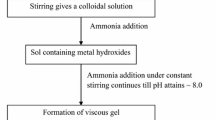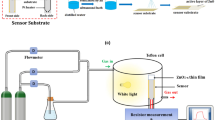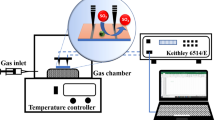Abstract
A basic zirconia oxygen sensor was utilized to monitor the gas–solid oxidation reaction characteristics of metal/metal-oxide powder beds. The method described allowed for simple determination of chemical reaction rate constants for the oxidation reactions. The signal output of the sensor was analyzed for oxidation of the powder bed and diffusion of oxygen into the powder bed. The oxygen transport mechanisms occurring inside the sensor were described to further understand the signal outputs from the powder bed, and a discussion of relevant thermodynamic and kinetic theory was provided. Two metal/metal-oxide systems were examined using this device to demonstrate its performance. The simple Ni/NiO system was chosen to demonstrate feasibility, and the complex W/WO3 system was chosen to demonstrate versatility of the sensor. Combining the experimental data with relevant kinetic theory, chemical reaction rate constants were calculated from plots of sensor ocv versus time for each reaction step during the metal oxidation sequences.












Similar content being viewed by others
References
Haboury R, Pal UB, Zink PA et al (2012) Study of an energy storage and recovery concept based on the W/WO3 redox reaction: part I. Kinetic study and modeling of the WO3 reduction process for energy storage. Metall Mater Trans B 43:1001–1010. doi:10.1007/s11663-012-9656-0
Bustnes JA, Sichen D, Seetharaman S (1993) Application of a nonisothermal thermogravimetric method to the kinetic study of the reduction of metallic oxides: part II. A theoretical treatment of powder bed reduction. Metall Mater Trans B 24B:475–480
Milshtein JD, Gergel DR, Basu SN et al (2015) Mixed ionic electronic conducting powder bed for grid level energy storage and release: a study of tungsten oxide reduction kinetics. Int J Hydrog Energy 40:3624–3632. doi:10.1016/j.ijhydene.2015.01.077
Milshtein JD, Gratz E, Basu SN et al (2013) Study of the two-step W/WO3 solar to fuel conversion cycle for syngas production. J Power Sources 236:95–102. doi:10.1016/j.jpowsour.2013.02.038
Belton GR, McCarron R (1964) The volatilization of tungsten in the presence of water vapor. J Phys Chem 33:1852–1856
Greene G, Finfrock C (2001) Vaporization of tungsten in flowing steam at high temperatures. Exp Therm fluid Sci 25:87–99
Lassner E, Schubert WD (1999) Tungsten: properties, chemistry, technology of the element, alloys, and chemical compounds. Springer, Heidelberg, p 422
Luo Z, Xiao J, Xia F (2006) Preparation and analysis of zirconia oxygen sensors. Trans Nonferrous Met Soc China 16:s82–s87
Krishnan A (2006) Solid oxide membrane process for the direct reduction of magnesium from magnesium oxide, p 153
Park J, Blumenthal RN (1989) Electronic transport in 8 mole percent. J Electrochem Soc 136:2867–2876
Balluffi RW, Allen SM, Carter WC (2005) Chemistry, technology of the element. Wiley, New York, pp 107–109
Pawel R (1974) Diffusion in a finite system with a moving boundary. J Nucl Mater 49:281–290
Roine A (2002) HSC chemistry, 5.11 ed. Outokumpu Research Oy, Pori
McBride BJ, Gordon S, Reno MA (1993) Thermodynamic data for fifty reference elements. NASA-TP-3287, N93-19977
Barin I (1993) Thermodynamic data of pure substances. VCH Vergagsgesellschaft mbH, Weinheim
Scientific Group Thermodata Europe (1999) Grenoble Campus, 1001 Avenue Centrale, BP 66. F-38402 Saint Martin d’Héres
Levenspiel O (1999) Chemical reaction engineering, 3rd edn. Wiley, New York, pp 566–586
Acknowledgments
The financial support of the Boston University Ignition Award is gratefully acknowledged. The assistance of Dr. Eric Gratz, Mr. Romain Haboury, and Mr. Robert Sjostrom is also greatly appreciated.
Author information
Authors and Affiliations
Corresponding author
Rights and permissions
About this article
Cite this article
Milshtein, J.D., Basu, S.N., Gopalan, S. et al. Simple method for determining metal power oxidation kinetics with a zirconia sensor. J Appl Electrochem 45, 1025–1034 (2015). https://doi.org/10.1007/s10800-015-0872-6
Received:
Accepted:
Published:
Issue Date:
DOI: https://doi.org/10.1007/s10800-015-0872-6




